Electro-Optical Comb Envelope Engineering Based on Mode Crossing
Abstract
1. Introduction
2. Theory and Numerical Simulation
3. Experiment Results
4. Conclusions
Author Contributions
Funding
Institutional Review Board Statement
Informed Consent Statement
Data Availability Statement
Acknowledgments
Conflicts of Interest
References
- Kippenberg, T.J.; Gaeta, A.L.; Lipson, M.; Gorodetsky, M.L. Dissipative Kerr solitons in optical microresonators. Science 2018, 361, eaan8083. [Google Scholar] [CrossRef]
- Wang, W.; Wang, L.; Zhang, W. Advances in soliton microcomb generation. Adv. Photonics 2020, 2, 034001. [Google Scholar] [CrossRef]
- Brasch, V.; Geiselmann, M.; Herr, T.; Lihachev, G.; Pfeiffer, M.H.; Gorodetsky, M.L.; Kippenberg, T.J. Photonic chip-based optical frequency comb using soliton Cherenkov radiation. Science 2016, 351, 357–360. [Google Scholar] [CrossRef]
- Herr, T.; Brasch, V.; Jost, J.D.; Wang, C.Y.; Kondratiev, N.M.; Gorodetsky, M.L.; Kippenberg, T.J. Temporal solitons in optical microresonators. Nat. Photonics 2013, 8, 145–152. [Google Scholar] [CrossRef]
- Liu, X.; Gong, Z.; Bruch, A.W.; Surya, J.B.; Lu, J.; Tang, H.X. Aluminum nitride nanophotonics for beyond-octave soliton microcomb generation and self-referencing. Nat. Commun. 2021, 12, 5428. [Google Scholar] [CrossRef] [PubMed]
- Yu, M.; Okawachi, Y.; Griffith, A.G.; Lipson, M.; Gaeta, A.L. Mode-locked mid-infrared frequency combs in a silicon microresonator. Optica 2016, 3, 854–860. [Google Scholar] [CrossRef]
- He, Y.; Yang, Q.; Ling, J.; Luo, R.; Liang, H.; Li, M.; Shen, B.; Wang, H.; Vahala, K.; Lin, Q. Self-starting bi-chromatic LiNbO3 soliton microcomb. Optica 2019, 6, 1138–1144. [Google Scholar] [CrossRef]
- Suh, M.G.; Vahala, K.J. Soliton microcomb range measurement. Science 2018, 359, 884–887. [Google Scholar] [CrossRef] [PubMed]
- Trocha, P.; Karpov, M.; Ganin, D.; Pfeiffer, M.H.P.; Kordts, A.; Wolf, S.; Krockenberger, J.; Marin-Palomo, P.; Weimann, C.; Randel, S.; et al. Ultrafast optical ranging using microresonator soliton frequency combs. Science 2018, 359, 887–891. [Google Scholar] [CrossRef]
- Riemensberger, J.; Lukashchuk, A.; Karpov, M.; Weng, W.; Lucas, E.; Liu, J.; Kippenberg, T.J. Massively parallel coherent laser ranging using a soliton microcomb. Nature 2020, 581, 164–170. [Google Scholar] [CrossRef]
- Papp, S.B.; Beha, K.; Del’Haye, P.; Quinlan, F.; Lee, H.; Vahala, K.J.; Diddams, S.A. Microresonator frequency comb optical clock. Optica 2014, 1, 10–14. [Google Scholar] [CrossRef]
- Marin-Palomo, P.; Kemal, J.N.; Karpov, M.; Kordts, A.; Pfeifle, J.; Pfeiffer, M.H.P.; Trocha, P.; Wolf, S.; Brasch, V.; Anderson, M.H.; et al. Microresonator-based solitons for massively parallel coherent optical communications. Nature 2017, 546, 274–279. [Google Scholar] [CrossRef]
- Ambrosetti, A.; Ferri, N.; DiStasio, R.A.; Tkatchenko, A. Wavelike charge density fluctuations and van der Waals interactions at the nanoscale. Science 2016, 351, 1171–1176. [Google Scholar] [CrossRef] [PubMed]
- Torres-Company, V.; Weiner, A.M. Optical frequency comb technology for ultra-broadband radio-frequency photonics. Laser Photonics Rev. 2014, 8, 368–393. [Google Scholar] [CrossRef]
- Rueda, A.; Sedlmeir, F.; Kumari, M.; Leuchs, G.; Schwefel, H.G.L. Resonant electro-optic frequency comb. Nature 2019, 568, 378–381. [Google Scholar] [CrossRef] [PubMed]
- Zhang, M.; Buscaino, B.; Wang, C.; Shams-Ansari, A.; Reimer, C.; Zhu, R.; Kahn, J.M.; Loncar, M. Broadband electro-optic frequency comb generation in a lithium niobate microring resonator. Nature 2019, 568, 373–377. [Google Scholar] [CrossRef]
- Zhang, K.; Sun, W.; Chen, Y.; Feng, H.; Zhang, Y.; Chen, Z.; Wang, C. A power-efficient integrated lithium niobate electro-optic comb generator. Commun. Phys. 2023, 6, 17. [Google Scholar] [CrossRef]
- Renaud, D.; Assumpcao, D.R.; Joe, G.; Shams-Ansari, A.; Zhu, D.; Hu, Y.; Sinclair, N.; Loncar, M. Sub-1 Volt and high-bandwidth visible to near-infrared electro-optic modulators. Nat. Commun. 2023, 14, 1496. [Google Scholar] [CrossRef]
- Lin, J.; Bo, F.; Cheng, Y.; Xu, J. Advances in on-chip photonic devices based on lithium niobate on insulator. Photonics Res. 2020, 8, 12001910. [Google Scholar] [CrossRef]
- Zhang, L.; Hao, Z.; Luo, Q.; Gao, A.; Zhang, R.; Yang, C.; Gao, F.; Bo, F.; Zhang, G.; Xu, J. Dual-periodically poled lithium niobate microcavities supporting multiple coupled parametric processes. Opt. Lett. 2020, 45, 3353–3356. [Google Scholar] [CrossRef]
- Lu, J.; Al Sayem, A.; Gong, Z.; Surya, J.B.; Zou, C.-L.; Tang, H.X. Ultralow-threshold thin-film lithium niobate optical parametric oscillator. Optica 2021, 8, 539–544. [Google Scholar] [CrossRef]
- Hao, Z.; Zhang, L.; Mao, W.; Gao, A.; Gao, X.; Gao, F.; Bo, F.; Zhang, G.; Xu, J. Second-harmonic generation using d33 in periodically poled lithium niobate microdisk resonators. Photonics Res. 2020, 8, 311–317. [Google Scholar] [CrossRef]
- Yang, C.; Yang, S.; Du, F.; Zeng, X.; Wang, B.; Yang, Z.; Luo, Q.; Ma, R.; Zhang, R.; Jia, D.; et al. 1550 nm Band Soliton Microcombs in Ytterbium-Doped Lithium Niobate Microrings. Laser Photonics Rev. 2023, 17, 2200510. [Google Scholar] [CrossRef]
- Yu, M.; Okawachi, Y.; Cheng, R.; Wang, C.; Zhang, M.; Gaeta, A.L.; Loncar, M. Raman lasing and soliton mode-locking in lithium niobate microresonators. Light. Sci. Appl. 2020, 9, 9. [Google Scholar] [CrossRef]
- Gong, Z.; Liu, X.; Xu, Y.; Tang, H.X. Near-octave lithium niobate soliton microcomb. Optica 2020, 7, 1275–1278. [Google Scholar] [CrossRef]
- Wang, C.; Zhang, M.; Chen, X.; Bertrand, M.; Shams-Ansari, A.; Chandrasekhar, S.; Winzer, P.; Loncar, M. Integrated lithium niobate electro-optic modulators operating at CMOS-compatible voltages. Nature 2018, 562, 101–104. [Google Scholar] [CrossRef]
- He, M.; Xu, M.; Ren, Y.; Jian, J.; Ruan, Z.; Xu, Y.; Gao, S.; Sun, S.; Wen, X.; Zhou, L.; et al. High-performance hybrid silicon and lithium niobate Mach–Zehnder modulators for 100 Gbit s−1 and beyond. Nat. Photonics 2019, 13, 359–364. [Google Scholar] [CrossRef]
- Hu, Y.; Yu, M.; Buscaino, B.; Sinclair, N.; Zhu, D.; Cheng, R.; Shams-Ansari, A.; Shao, L.; Zhang, M.; Kahn, J.M.; et al. High-efficiency and broadband on-chip electro-optic frequency comb generators. Nat. Photonics 2022, 16, 679–685. [Google Scholar] [CrossRef]
- Shams-Ansari, A.; Yu, M.; Chen, Z.; Reimer, C.; Zhang, M.; Picqué, N.; Lončar, M. Thin-film lithium-niobate electro-optic platform for spectrally tailored dual-comb spectroscopy. Commun. Phys. 2022, 5, 88. [Google Scholar] [CrossRef]
- Hu, Y.; Yu, M.; Sinclair, N.; Zhu, D.; Cheng, R.; Wang, C.; Loncar, M. Mirror-induced reflection in the frequency domain. Nat. Commun. 2022, 13, 6293. [Google Scholar] [CrossRef]
- Bao, C.; Xuan, Y.; Leaird, D.E.; Wabnitz, S.; Qi, M.; Weiner, A.M. Spatial mode-interaction induced single soliton generation in microresonators. Optica 2017, 4, 1011–1015. [Google Scholar] [CrossRef]
- Zhang, K.; Chen, Y.; Sun, W.; Chen, Z.; Feng, H.; Wang, C. Spectral Engineering of Optical Microresonators in Anisotropic Lithium Niobate Crystal. Adv. Photonics 2024, e2308840. [Google Scholar] [CrossRef]
- Herr, T.; Brasch, V.; Jost, J.D.; Mirgorodskiy, I.; Lihachev, G.; Gorodetsky, M.L.; Kippenberg, T.J. Mode spectrum and temporal soliton formation in optical microresonators. Phys. Rev. Lett. 2014, 113, 123901. [Google Scholar] [CrossRef]
- Weng, H.; Afridi, A.A.; Li, J.; McDermott, M.; Tu, H.; Barry, L.P.; Lu, Q.; Guo, W.; Donegan, J.F. Dual-mode microresonators as straightforward access to octave-spanning dissipative Kerr solitons. APL Photonics 2022, 7, 066103. [Google Scholar] [CrossRef]
- Helgason, O.B.; Girardi, M.; Ye, Z.; Lei, F.; Schroder, J.; Torres-Company, V. Surpassing the nonlinear conversion efficiency of soliton microcombs. Nat. Photonics 2023, 17, 992–999. [Google Scholar] [CrossRef]
- Black, J.A.; Brodnik, G.; Liu, H.; Yu, S.-P.; Carlson, D.R.; Zang, J.; Briles, T.C.; Papp, S.B. Optical-parametric oscillation in photonic-crystal ring resonators. Optica 2022, 9, 1183–1189. [Google Scholar] [CrossRef]
- Ji, X.; Liu, J.; He, J.; Wang, R.N.; Qiu, Z.; Riemensberger, J.; Kippenberg, T.J. Compact, spatial-mode-interaction-free, ultralow-loss, nonlinear photonic integrated circuits. Commun. Phys. 2022, 5, 84. [Google Scholar] [CrossRef]
- Zhang, L.; Jie, L.; Zhang, M.; Wang, Y.; Xie, Y.; Shi, Y.; Dai, D. Ultrahigh-Q silicon racetrack resonators. Photonics Res. 2020, 8, 684–689. [Google Scholar] [CrossRef]
- Buscaino, B.; Zhang, M.; Loncar, M.; Kahn, J.M. Design of Efficient Resonator-Enhanced Electro-Optic Frequency Comb Generators. J. Light. Technol. 2020, 38, 1400–1413. [Google Scholar] [CrossRef]
- Jiang, X.; Shao, L.; Zhang, S.X.; Yi, X.; Wiersig, J.; Wang, L.; Gong, Q.; Loncar, M.; Yang, L.; Xiao, Y.F. Chaos-assisted broadband momentum transformation in optical microresonators. Science 2017, 358, 344–347. [Google Scholar] [CrossRef] [PubMed]
- Bontempi, F.; Andriolli, N.; Scotti, F.; Chiesa, M.; Contestabile, G. Comb Line Multiplication in an InP Integrated Photonic Circuit Based on Cascaded Modulators. IEEE J. Sel. Top. Quantum Electron. 2019, 25, 1–7. [Google Scholar] [CrossRef]
- Demirtzioglou, I.; Lacava, C.; Bottrill, K.R.H.; Thomson, D.J.; Reed, G.T.; Richardson, D.J.; Petropoulos, P. Frequency comb generation in a silicon ring resonator modulator. Opt. Express 2018, 26, 790–796. [Google Scholar] [CrossRef]
- Kowligy, A.S.; Carlson, D.R.; Hickstein, D.D.; Timmers, H.; Lind, A.J.; Schunemann, P.G.; Papp, S.B.; Diddams, S.A. Mid-infrared frequency combs at 10 GHz. Opt. Lett. 2020, 45, 3677–3680. [Google Scholar] [CrossRef]
- Wang, C.; Li, Z.; Riemensberger, J.; Lihachev, G.; Churaev, M.; Kao, W.; Ji, X.; Blesin, T.; Davydova, A.; Chen, Y. Lithium tantalate electro-optical photonic integrated circuits for high volume manufacturing. arXiv 2023, arXiv:2306.16492. [Google Scholar]

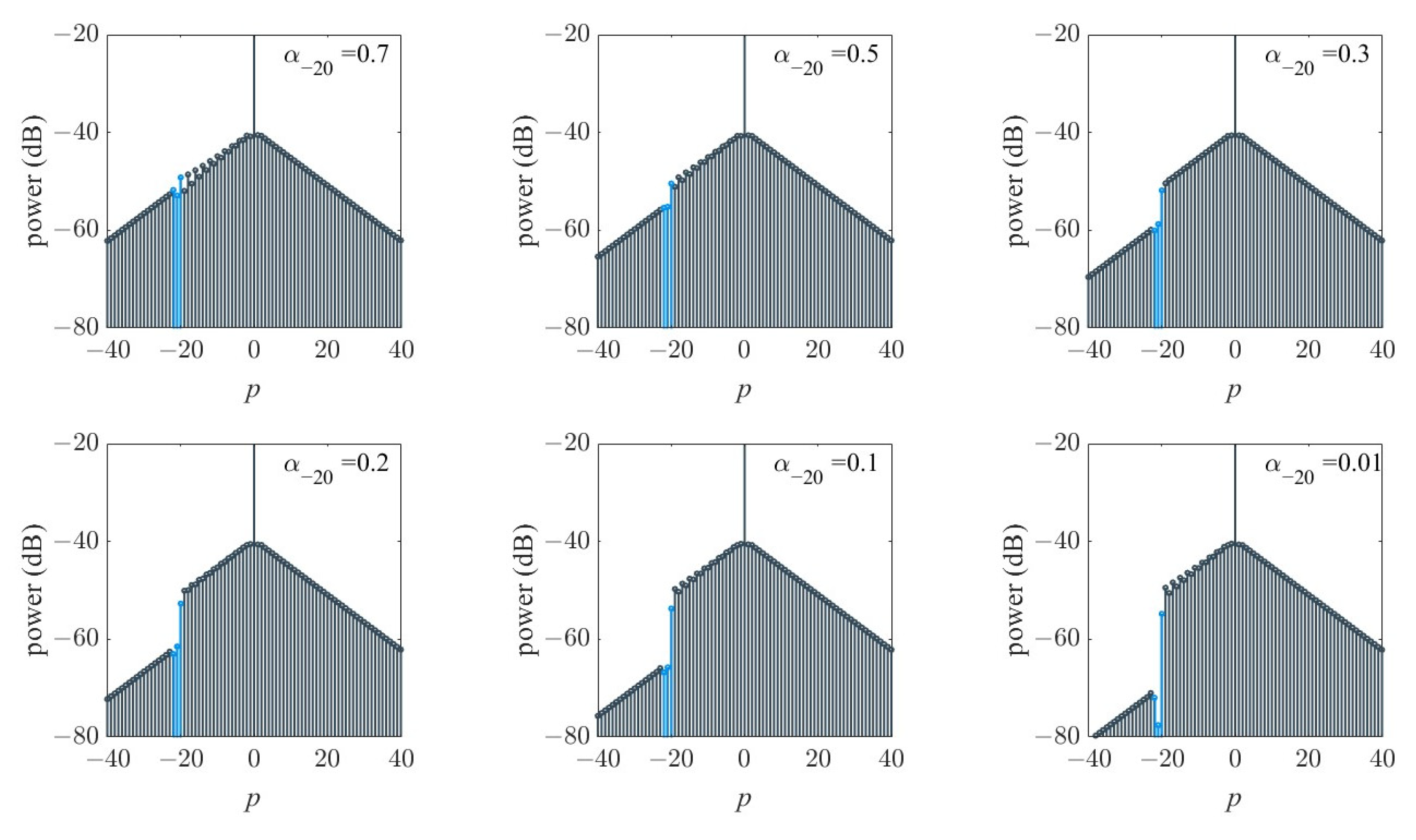
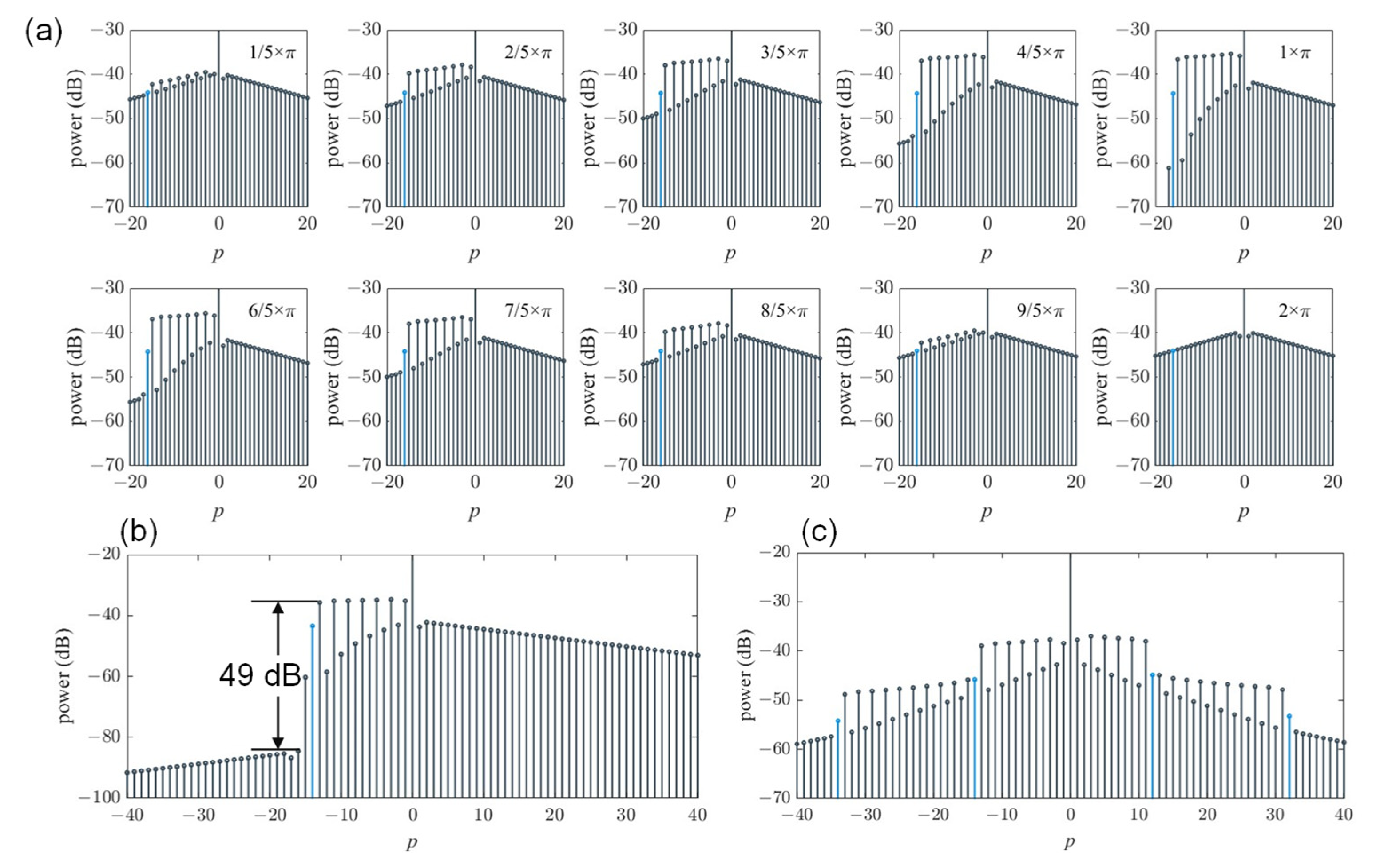
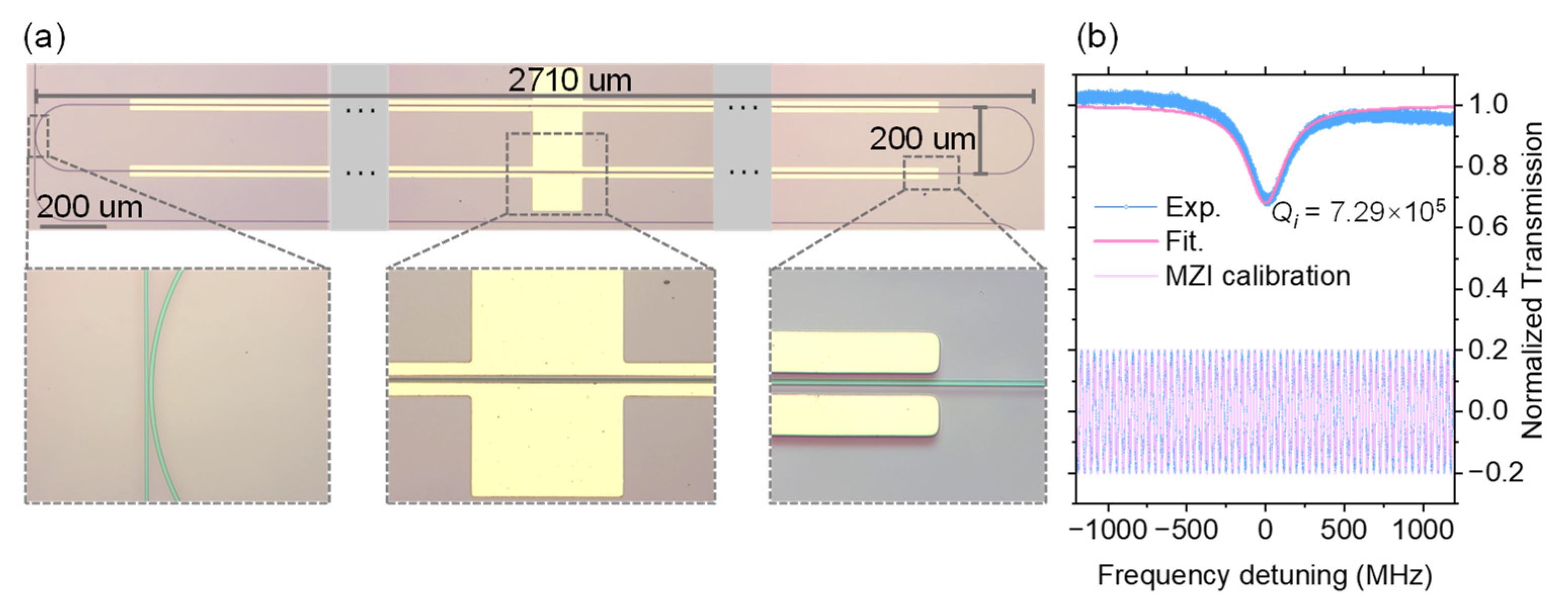
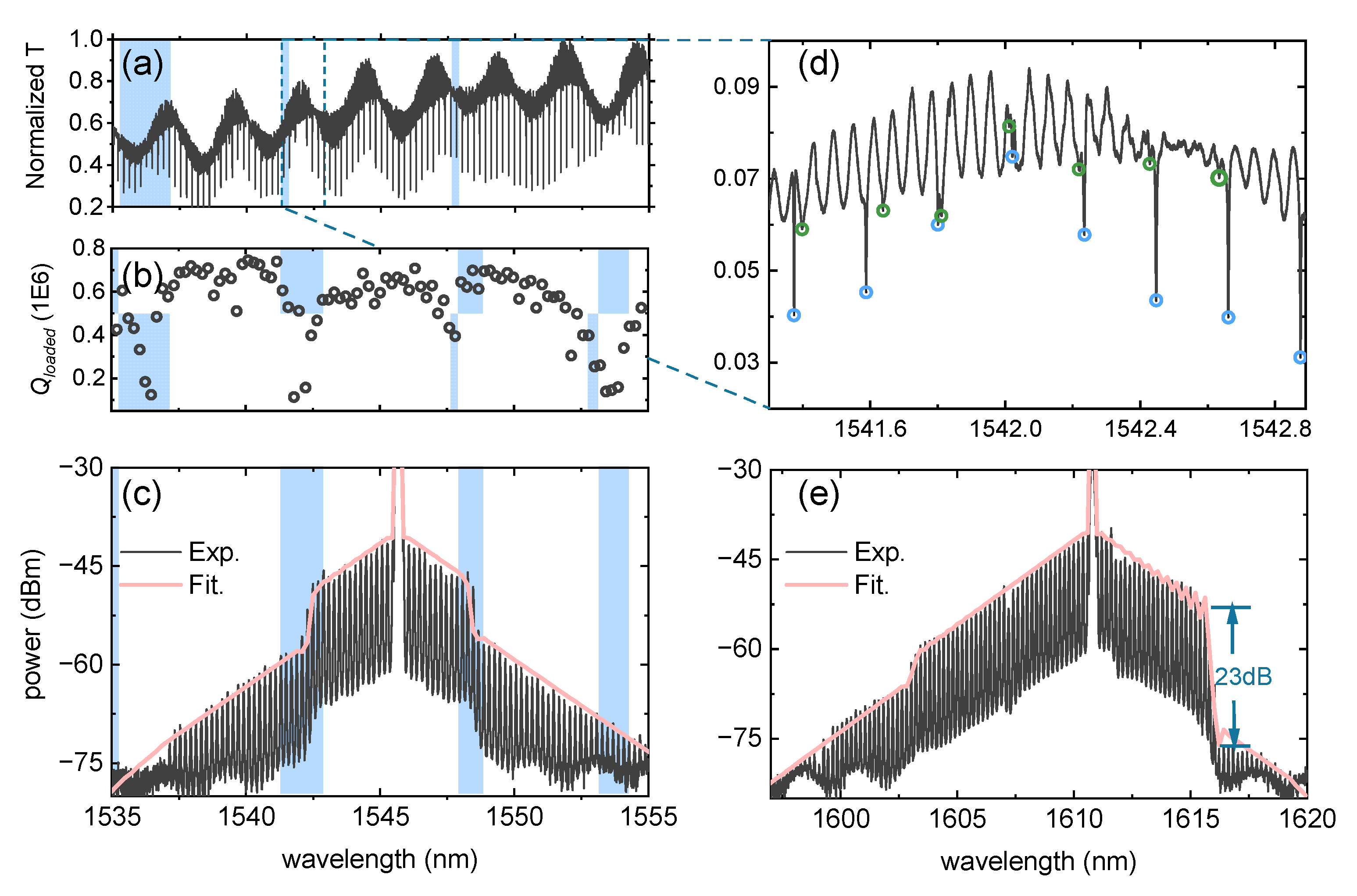
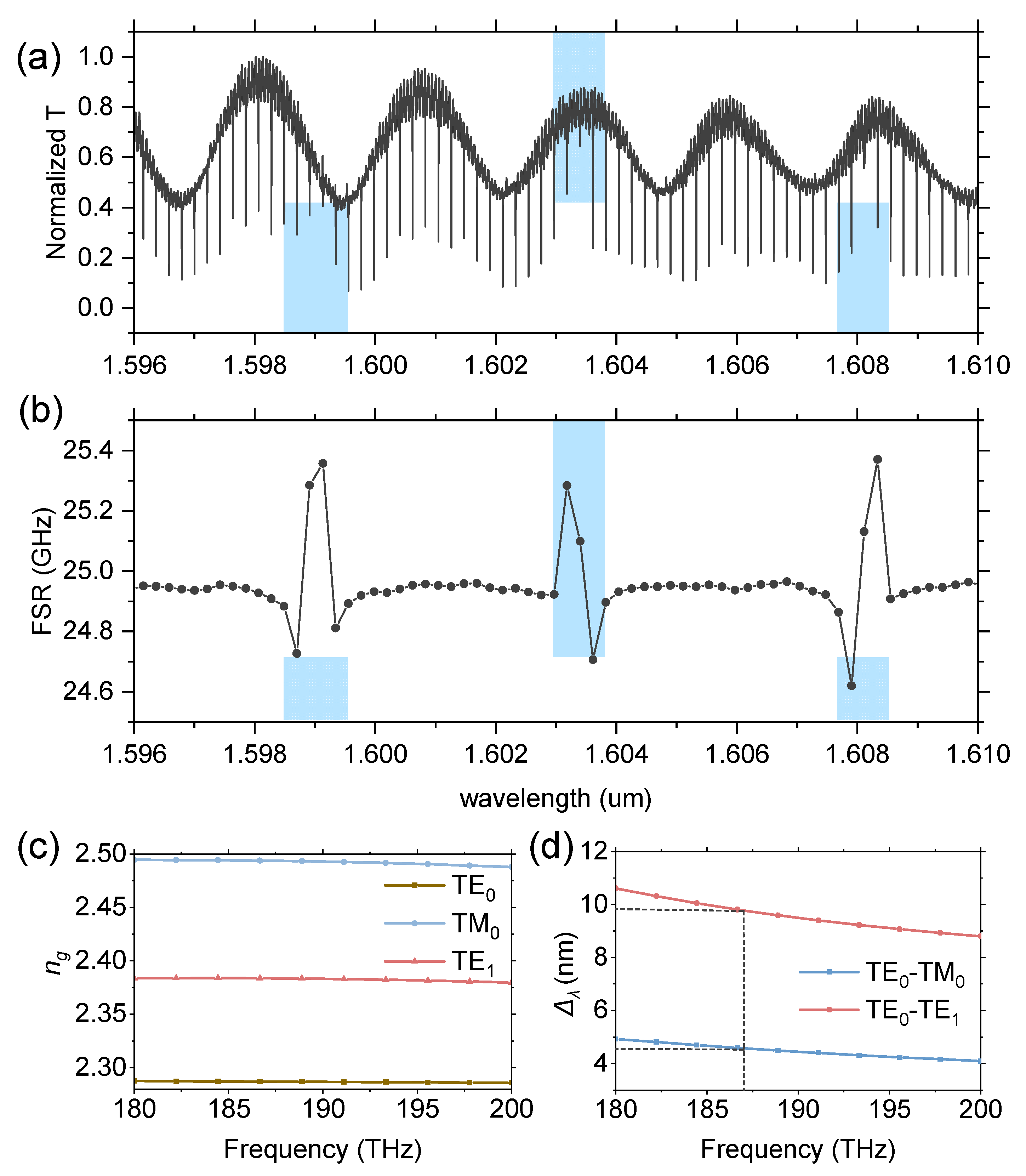
Disclaimer/Publisher’s Note: The statements, opinions and data contained in all publications are solely those of the individual author(s) and contributor(s) and not of MDPI and/or the editor(s). MDPI and/or the editor(s) disclaim responsibility for any injury to people or property resulting from any ideas, methods, instructions or products referred to in the content. |
© 2024 by the authors. Licensee MDPI, Basel, Switzerland. This article is an open access article distributed under the terms and conditions of the Creative Commons Attribution (CC BY) license (https://creativecommons.org/licenses/by/4.0/).
Share and Cite
Kang, S.; Lv, X.; Yang, C.; Ma, R.; Gao, F.; Yu, X.; Bo, F.; Zhang, G.; Xu, J. Electro-Optical Comb Envelope Engineering Based on Mode Crossing. Materials 2024, 17, 1190. https://doi.org/10.3390/ma17051190
Kang S, Lv X, Yang C, Ma R, Gao F, Yu X, Bo F, Zhang G, Xu J. Electro-Optical Comb Envelope Engineering Based on Mode Crossing. Materials. 2024; 17(5):1190. https://doi.org/10.3390/ma17051190
Chicago/Turabian StyleKang, Shuting, Xiaomin Lv, Chen Yang, Rui Ma, Feng Gao, Xuanyi Yu, Fang Bo, Guoquan Zhang, and Jingjun Xu. 2024. "Electro-Optical Comb Envelope Engineering Based on Mode Crossing" Materials 17, no. 5: 1190. https://doi.org/10.3390/ma17051190
APA StyleKang, S., Lv, X., Yang, C., Ma, R., Gao, F., Yu, X., Bo, F., Zhang, G., & Xu, J. (2024). Electro-Optical Comb Envelope Engineering Based on Mode Crossing. Materials, 17(5), 1190. https://doi.org/10.3390/ma17051190





